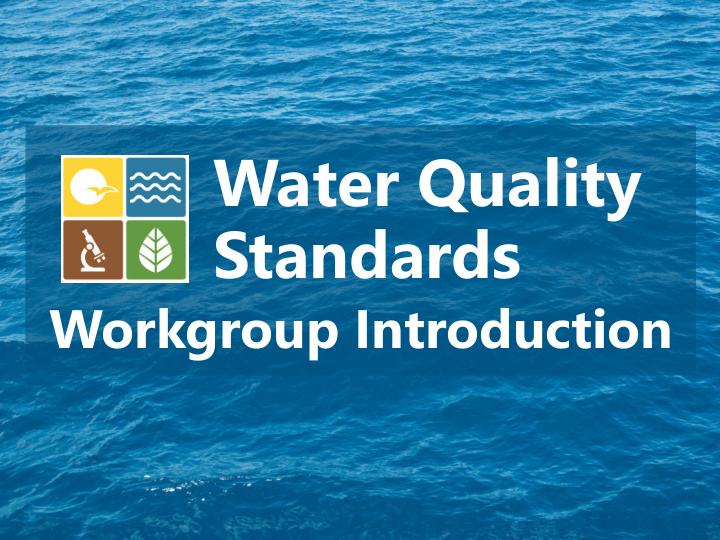



Water Quality Standards Workgroup Introduction
Purpose of WQS Workgroup This workgroup will provide input and assistance to the Department in developing and refining appropriate water quality standards for the protection of Missouri’s streams, lakes, and wetlands. Workgroup last met in 2015 while • working on nutrient criteria Reconvening the workgroup for the • 2019/2020 triennial review Will make plans for future meetings • 2
2018 WQS Rulemaking Status • Published in CSR April 2018 • “Alaska Rule” [40 CFR 131.21] WQS cannot be used for CWA purposes until after EPA approval • EPA approved NNC for lakes • Waiting on EPA approval for all other items 3
2018 WQS Rulemaking Status Items Awaiting EPA Approval: • Waters of the State • Losing Stream Reference Definition and Table J • Mixing Zones and ZIDs • Modify Site-Specific Criteria Table • Hardness • MUDD Update • pH (4-day average) • Section 304(a) Water Quality • General Criteria Revisions Criteria • Antidegradation • WQS Variance - Kirksville Implementation Procedure • MDV Framework • Miscellaneous Text Revisions 4
WQS Projects A new way to conduct WQS work! GOAL: Separate WQS projects from rulemaking WQS Unit staff will work on projects according to priority. The rulemaking timeline will not dictate the projects we work on. Pre- Project Technical Ready for Planning Planning Review Rulemaking (Queue) 5
2019/2020 WQS Rulemaking GOAL: 18 month rulemaking Working out the detailed timeline, but goal is to publish in the CSR before the end of 2020 6
Meeting Dates and Times 2019/2020 Triennial Review Meetings 1 p.m. to 3 p.m. • July 23 • August 6 • September 13 • September 24 September 18 th is reserved as flex if needed 7
Meeting Format 1. Review items discussed/decided on from previous meeting(s) 2. Overview of the day’s meeting 3. Topic presentation 4. Open discussion/questions • WQS Unit’s recommendation • Implementation 5. Closing remarks and preview of next meeting 8
Reference and Recommendations Includes: • Summary of our technical review • Rulemaking history • WQS Unit’s recommendations to the group • Starting point for discussions 9
WQS Workgroup Web Page https://dnr.mo.gov/env/wpp/cwforum/adv-uncl-waters-wetlands.htm 10
2019/2020 Triennial Review SCOPE 11
Scope – What’s In? • Aluminum • Site-specific DO criteria (Blue Springs) • Cadmium (acute) • Site-specific chloride • Copper BLM vs. WER criteria (Smithfield) • Chloride plus sulfate • Losing stream language • DWS and IND use review moved to 7.015 • MUDD WBID revision by • AIP moved to 7.015 watershed • MDV Framework revisions • Variances – Joplin, Salem, • Update MUDD with UAA Bolivar and presumed use review results 12
Scope – What’s In? • Tentative schedule of topics in folder • Flex time • Flex date • Will update as needed 13
Rule Text and Table Review • Copy of current rule text in folders • List of Tables in folders • Will provide redlined version to workgroup later 14
Scope – What’s Out? Disclaimer: These are items that have been brought up in previous discussions and/or comment letters through the years and recorded by the WQS Unit. It is not considered an all-inclusive list, nor are all of the items projects the WQS Unit will pursue. • Regional DO • Cold water use review • Mollusk ammonia • Bacteria and pathogens • Human health protection 304(a) • WBC-A for lakes on public lands • Aquatic Life UAA Protocol • Cyanotoxins • Water body-specific NNC • NNC for lakes – recreational use • Chlorides and sulfates • Hydrologic classifications • Wetlands • Natural conditions provision • Copper • Outstanding State Resource Waters • NNC for streams and rivers • NNC for lakes – BRP ecoregion 15 • Selenium
Regional Dissolved Oxygen • Bootheel ditches • Low gradient • Low sinuosity • Multi-year Study • Continuous DO data • Biological data • Analyze data to establish DO criteria for the region on channelized streams 16
Mollusk Ammonia • Presence/Absence of mollusks: mussels and gill-breathing snails • Create distribution maps • Investigate implementation options (limit derivation) • Treatment costs • How can this fit in to the MDV Framework? 17
304(a) Criteria for HHP Concerns from previous rulemaking: • Fish consumption rates • Drinking water volumes • Cancer risk rates • “Compounding Conservatism” 18
Aquatic Life UAA AQL UAA Protocol was • worked on around 2013- 2015 Current staff need to • familiarize themselves with this previous work Reintroduce topic and • draft protocol to workgroup for discussion 19
Chlorides and Sulfates • Previous disapproval of hardness-based criteria • Request of EPA to develop recommendations for these criteria 20
Lake-Specific NNC Reevaluate site-specific nutrient criteria • Are the state-wide NNC also protective of these • lakes? Divers at Table Rock Lake 21
Wetlands Classify wetlands on public lands • Establish and assign wetland designated uses • Narrative criteria for wetlands • To Do: Collect more data • on reference wetlands (EPA offers grant money for this) Research wetland • WQS in other states 22
WQS Inventory of Projects Released at end of each calendar year 23
WQS Inventory of Projects WQS Workgroup Meetings will resume late this year/early next year • How frequent? • Every other month • Quarterly • Standing presentation at quarterly forum • Webinars 24
Questions? 25
Recommend
More recommend